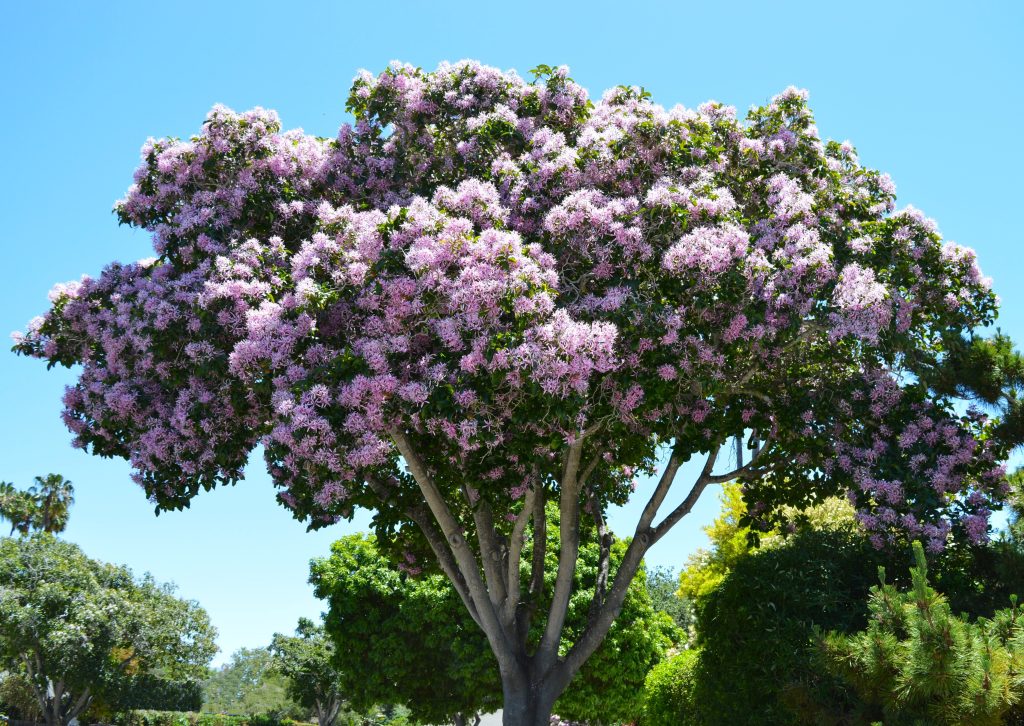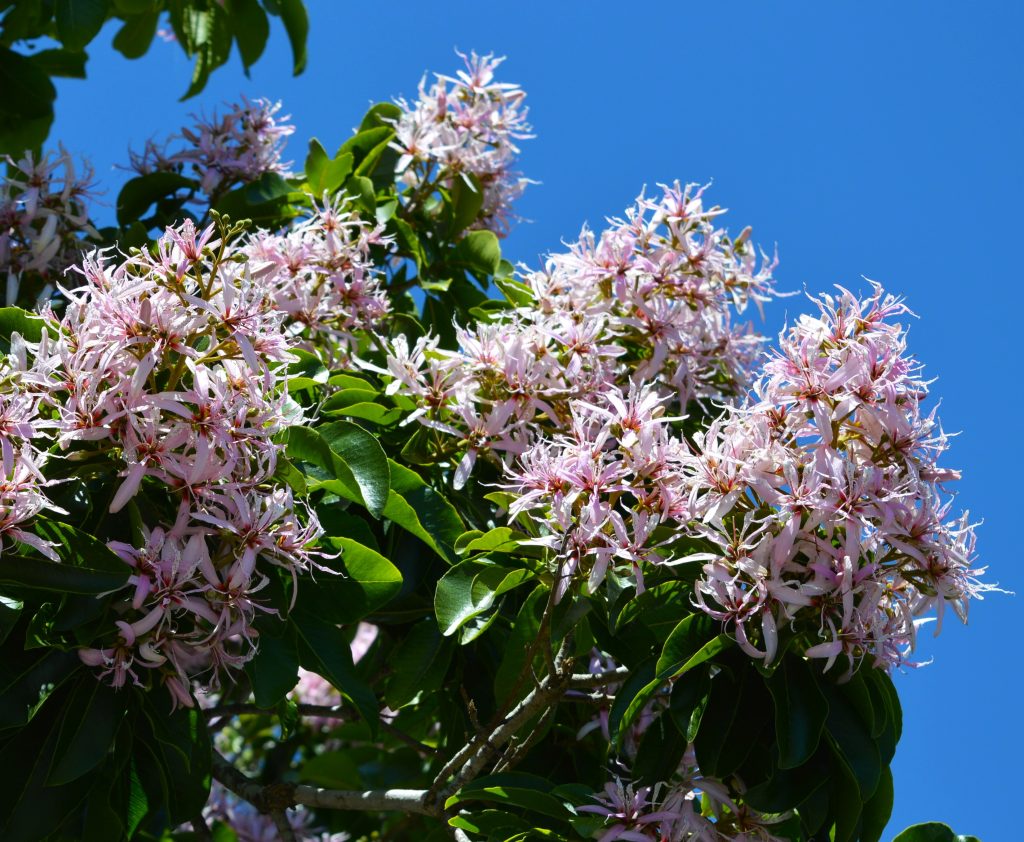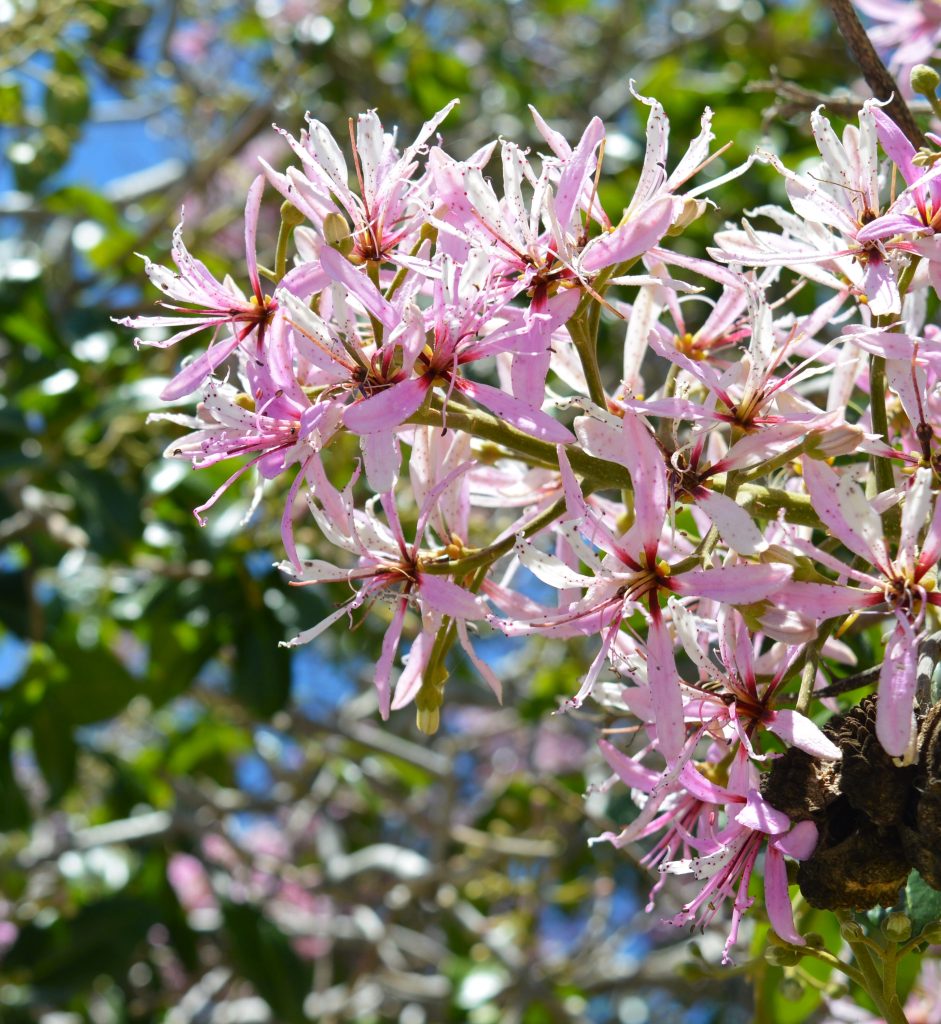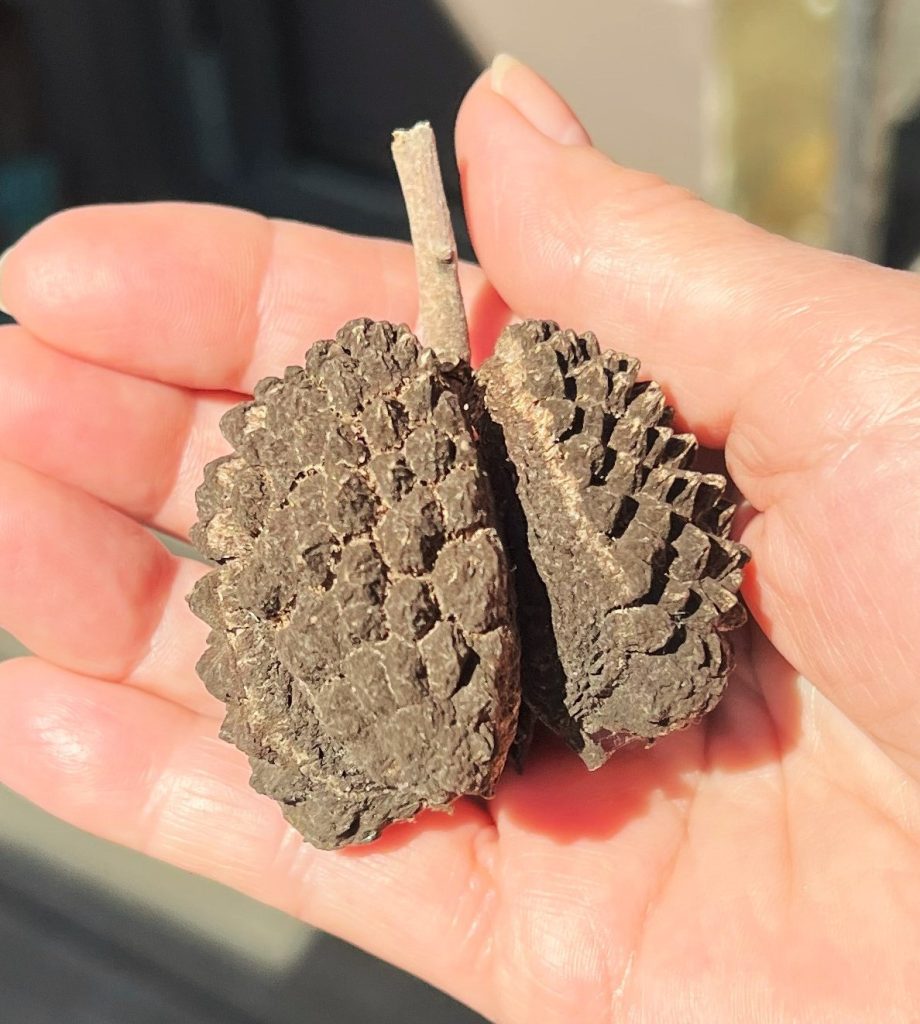Tree of the Month, May 2023
Cape Chestnut
Calodendrum capense
 The Cape Chestnut is one of the loveliest flowering trees seen in our area. In late spring and early summer, its spikes of vibrant pink flowers can cover the entire tree canopy. Even though it has been planted in Santa Barbara since the late1800s, there are relatively few now available for public viewing.
The Cape Chestnut is one of the loveliest flowering trees seen in our area. In late spring and early summer, its spikes of vibrant pink flowers can cover the entire tree canopy. Even though it has been planted in Santa Barbara since the late1800s, there are relatively few now available for public viewing.
Cape Chestnut is a small- to medium-sized tree with a height and spread of 25 to 40 feet. It is deciduous or semi-deciduous, depending on the weather and the location. Its rounded crown provides a dense canopy covered with glossy dark green leaves (2- to 9- inches long and 1- to 4-inches wide), ovate to elliptical in shape, with smooth edges.
Once the tree is adorned with its foliage, its flowers emerge in a spectacular floral display from May through July. The lightly fragrant flowers are clustered in upright panicles at the ends of the branches. Each flower has five light pink to rose pink sepals (modified leaves) that look like radiating petals (up to 2 inches across). In addition, there are five petal-like upright stamens (male parts of the flower) that are pale pink with red or maroon-colored dots. Each flower is “perfect”, which means it holds both male and female reproductive parts. Bees are wildly attracted to the bounty of pollen and nectar provided by a Cape Chestnut in full flower; the air will buzz loudly with their activity.
After pollination, the pistils (female parts of the flower) develop to produce fruit capsules (2- inches in diameter). The capsules have five lobes and a distinctively knobby surface. When newly formed, these capsules are bright green – with age, they turn brown; at maturity, each lobe splits open to disperse shiny black seeds (up to ½-inch in diameter).
The smooth bark is light gray in color, which is a sharp contrast under its deep green foliage.
Its common names, “Cape Chestnut” and “Wild Chestnut”, were given to it by British naturalist and explorer, William Burchell (1781-1863), because its flowers and fruit capsules resembled the Horse Chestnut, although it is, in fact, not closely related to true chestnuts.
Actually, the Cape Chestnut is in the Citrus (Rutaceae) plant family. The botanical name for the Cape Chestnut is Calodendrum capense. The genus name, Calodendrum, is derived from the combination of the Greek words “kalos” (meaning “beautiful”) and “dendron” (meaning tree”). The name Calodendrum was given by the Swedish naturalist, Carl Peter Thunberg (1743-1828), who is known as the father of South African botany. The specific epithet, capense, is from Latin, and means “from the Cape”, referring to its native habitat.
The Cape Chestnut is native to Africa, in a wide range covering the band of coastal forest stretching from the southern Cape region of South Africa up to the highlands of Kenya and Ethiopia. It is well adapted to the Mediterranean climate found in the Cape and in Santa Barbara, as well as to the tropical and subtropical climates of its other native areas,
The aboriginal peoples of Africa believe Cape Chestnut seeds have magical powers to bestow skill and luck on humans. More realistically, the seeds are harvested and processed for their oil, known as Yangu oil, which is used for sun protection and for the preparation of soaps, skin care products, and cosmetics. The leaves have translucent oil-bearing glands; this leaf oil is used to make pharmaceuticals, including one to treat glaucoma. The wood is hard, yet surprisingly easy to work with, thereby making it extremely useful for tools, furniture, and planks. The bark is used as an ingredient for skin conditions in traditional medicine.
Cape Chestnut should be planted in full sun and protected from wind and direct coastal exposure. It can grow in a variety of soils but does best in deep loam. It will require some irrigation during the dry season and during droughts. When young, it is frost-sensitive; when mature, it can survive temperatures of 20 degrees F. It is not susceptible to any serious insect predation or plant diseases. It requires little maintenance, other than occasional minor pruning. It can take 5 to 7 years from planting to begin flowering.
Cape Chestnut can be propagated from seed or by cuttings. Fresh seeds planted in late summer (just after they first drop) can germinate in 10 to 40 days. Older seeds will take longer to germinate. Cuttings should be taken in spring, treated with rooting hormone, and provided with misting and bottom heat.
For the time being, local propagation may be the only way to obtain Cape Chestnut trees in our area, because shipment of potted trees is currently restricted by order of the California State Food and Agriculture Department. The problem is that, since Cape Chestnut is in the Citrus family, it is a potential host to the Asian Citrus Psyllid, a leaf-sap-sucking insect that can carry the bacterium for Huanglongbing (HLB) disease, also known as “citrus greening disease”. This disease detrimentally affects citrus fruit so that it stays green and never ripens. More importantly, in 3 to 5 years, it will kill certain species of citrus, primarily oranges. While Cape Chestnut itself is not affected by HLB, it still is subject to onerous quarantine orders prohibiting shipment out of California counties; therefore, it is unlikely to be found in our local nurseries, unless they propagate Cape Chestnut on their own premises.
Though rare and somewhat difficult to procure in our area, Cape Chestnut is a magnificent flowering tree and makes a stunning ornamental tree in gardens, parks, and commercial landscapes. It would be well worth your effort to source one to plant out.
Mature Cape Chestnuts can be seen in several locations in our community as street trees: on Portofino Way, and one on Calle De Los Amigos in Hidden Valley; and two trees on the grounds of UCSB, one near the southeast corner of Hollister Avenue and San Marcos Road.
Tree-of-the-Month articles are sponsored by Santa Barbara Beautiful, whose many missions include the increase of public awareness and appreciation of Santa Barbara’s many outstanding trees and, in a long-time partnership with the City Parks & Recreation Department, the funding and planting of trees along the City’s streets.
Those who wish to honor a special someone can do so with an attractive commemorative marker that will be installed at the base of an existing street tree in the City of Santa Barbara. Because Santa Barbara Beautiful has participated in the planting to date of over 13,000 street trees, there are plenty of trees from which to choose! Application forms are available on the Santa Barbara Beautiful website, www.sbbeautiful.org.
Article and Photos by David Gress



